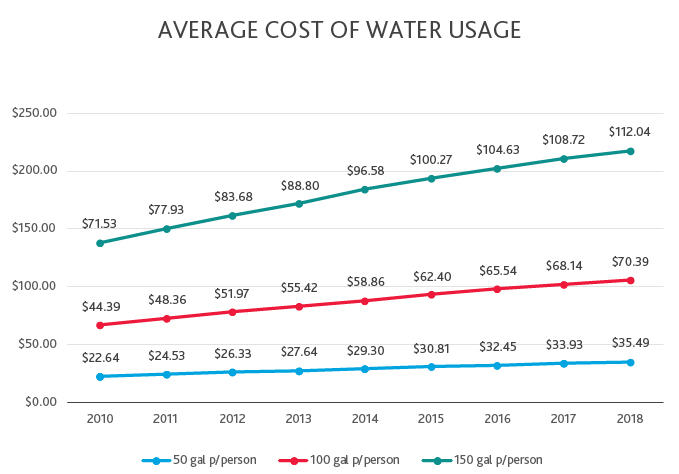Addressing the Drought of Financing for Water Infrastructure in the United States
Since the dawn of time, humans have worked to satisfy their need for potable water. Whether that meant walking to a local lake or stream, constructing aqueducts and reservoirs to transport and store water, putting a pump in the ground to draw water out of an aquifer, or simply turning on a tap, water is a necessity for our survival.
In addition to needing water to drink, we also need it to irrigate farmland, manufacture certain products and protect against fire. Once we were able to develop the means to store and distribute water, we were also faced with the need to dispose of the water we used in a safe, convenient and environmentally-friendly way.
This led to the construction of water distribution networks, sewer lines and treatment facilities to handle the inflow and outflow of water – which today we often take for granted. With this new infrastructure came the costs to maintain, repair, expand and update existing water systems.
Currently in the U.S., it’s estimated that approximately 240 million Americans (76% of the overall population) rely on the 800,000 miles of public sewers, 500,000 miles of private lateral sewers and 14,750 wastewater treatment plants.[1] In the next two decades, the number of people reliant on this infrastructure is expected to increase by 56 million, or approximately 23%.[2]
This is a concerning trend when you factor in that the American Society of Civil Engineers gave U.S. drinking water infrastructure a D and the wastewater infrastructure a D+ earlier in 2019. The Environmental Protection Agency (EPA) has estimated that $271 billion is needed over the next two decades to install additional piping, repair the existing piping and construct 530 new treatment facilities in order to meet the current and future demands of our national water infrastructure. [3] Some groups say the price tag is actually upwards of $1 trillion.
The impetus to repair U.S. water infrastructure is based upon the age of existing systems. It’s estimated that the U.S. has approximately 240,000 water main breaks per year as a result of over-used and aged infrastructure.[4] For example, in Philadelphia, half of the mains were installed prior to 1930, and some pipes installed prior to the Civil War are still in use.[5] Atlanta still relies upon pipelines that were originally installed between 1893 and 1924. It’s estimated that some cities are relying on piping that is more than 150 years old[6].
The type of piping used is also of some concern since the majority of piping installed in the U.S. between 1870 and 1970 consisted mainly of steel, cast iron, cement-lined cast iron and asbestos cement construction which have estimated useful lives of approximately 75 to 100 years. More reliable piping made of PVC and prestressed concrete were not introduced until the mid-1950s. In addition, there are countless miles of smaller lead and copper pipes that over time have become severely corroded.
Historically, the gap between the rate base and the actual cost to operate the infrastructure was covered under subsidies from local, state and federal sources, which have since dwindled. As a result, the average rates charged to a family of four in the United States have risen substantially from 2010 to 2018 based upon total consumption as indicated in the following table. According to this data, the average cost of water usage for a family of four at 150 gallons per person has increased approximately 57% from 2010 to 2018.
Average Water Rates for Family of Four

Source: Circle of Blue
We’ve seen some initial steps to solve for this problem. In 2014, Congress passed the Water Infrastructure Finance and Innovation Act (WIFIA), providing loans for water infrastructure projects up to 49% of the total project costs. Beginning in 2017, eligible borrowers under WIFIA include local, state, tribal and federal government entities as well as private and corporate entities. The EPA estimates that this appropriation could result in approximately $1 billion in loans supporting up to $2 billion in water and wastewater infrastructure investments. Through the federal-state partnership under Clean Water State Revolving Fund, approximately $42 billion has been loaned to fifty states, including the District of Columbia and Puerto Rico, resulting in approximately $126 billion in wastewater infrastructure improvements.[7]
Over the last several years, private ownership of municipal water systems has become another possible financial option to ease the strain on consumers and municipalities. However, given the public need for safe and affordable water access, this approach often requires oversight.
As a result of the increasing demand for water, combined with the depletion of sources such as rivers, lakes and aquafers, the question is not how but when major investments will be needed in the U.S. to ensure that clean water is readily available. To do so, it will take a combination of public, private and consumer support to ensure a sustainable, long-lasting and systemic fix.
[1] 2017 Infrastructure Report Card; American Society of Civil Engineers
[2] 2017 Infrastructure Report Card; American Society of Civil Engineers
[3] 2017 Infrastructure Report Card; American Society of Civil Engineers
[4] The Age of U.S. Water Pipes; Circle of Blue
[5] The Age of U.S. Water Pipes; Circle of Blue
[6] New York Times; $300 Billion War Beneath the Streets: Fighting to Replace America’s Water Pipes; November 10, 2017
[7] 2017 Infrastructure Report Card; American Society of Civil Engineers
SHARE